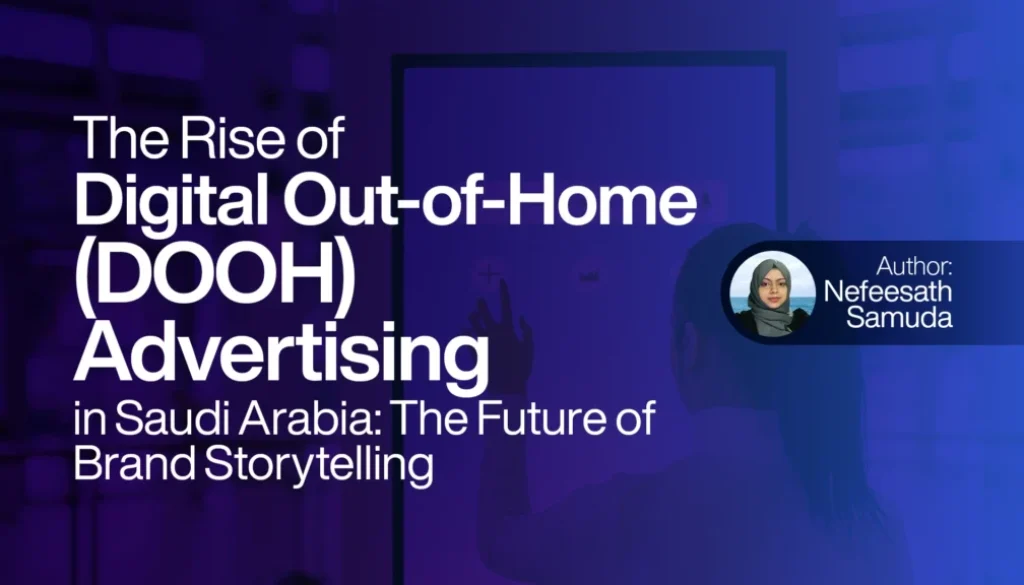The Rise of Digital Out-of-Home Advertising in Saudi Arabia: The Future of Brand Storytelling
As Saudi Arabia rapidly transforms into a global hub for innovation and technology, digital marketing is experiencing a revolution. One of the most significant trends shaping the industry is Digital Out-of-Home (DOOH) advertising. With the expansion of smart cities, digital billboards, and AI-driven advertisements, Saudi Arabia is redefining how brands communicate with consumers. This blog explores the rise of DOOH advertising in the Kingdom, its impact on brand storytelling, and what the future holds for this dynamic marketing trend.
Table of Contents
The Evolution of DOOH Advertising
Out-of-home (OOH) advertising has been a part of marketing for decades, from traditional billboards to transit ads. However, with advancements in digital screens, interactive content, and programmatic technology, DOOH advertising has taken outdoor marketing to a new level. Unlike static billboards, DOOH allows brands to display dynamic, data-driven, and personalized advertisements, making it more engaging and relevant for consumers.
In Saudi Arabia, this shift is evident in major cities like Riyadh, Jeddah, and Dammam, where smart billboards, LED screens, and AI-powered digital displays are transforming urban landscapes into immersive marketing experiences. With the Saudi Vision 2030 initiative emphasizing digital transformation, DOOH is gaining momentum as a high-impact, real-time marketing channel.
Why DOOH Advertising is Thriving in Saudi Arabia
Several factors are fueling the rapid adoption of DOOH advertising in the Kingdom:
- Smart City Initiatives: With projects like NEOM, The Line, and New Murabba, Saudi Arabia is integrating digital technology into urban infrastructure. Smart billboards with real-time data analytics are enhancing customer engagement and brand visibility.
- Increased Digitalization: As Saudi Arabia undergoes a digital revolution, brands are investing in high-tech advertising solutions to connect with a tech-savvy audience. The rise of 5G technology is further enabling real-time content updates on digital screens.
- Consumer Engagement: Unlike traditional static billboards, interactive DOOH displays can engage consumers with QR codes, augmented reality (AR), and AI-driven ads tailored to demographics, time of day, and location.
- Programmatic Advertising: DOOH enables data-driven, automated ad placements that adjust content based on real-time analytics, ensuring maximum impact and relevance.
- High Foot Traffic Locations: Saudi Arabia’s shopping malls, airports, highways, and stadiums are prime locations for DOOH advertising, offering brands an opportunity to capture large, diverse audiences.
The Impact of DOOH on Brand Storytelling
Traditional advertising often struggles to create meaningful brand-consumer interactions. However, DOOH changes the game by offering brands a dynamic storytelling platform. Here’s how:
- Immersive Content: Brands can use motion graphics, AI-driven recommendations, and real-time data to create personalized storytelling experiences.
- Contextual Relevance: Advertisers can tailor content based on weather, time, audience demographics, and current events, making messaging more relevant.
- Engagement & Interactivity: Features like touchscreen billboards, QR codes, and AR experiences encourage audience participation, strengthening brand recall.
- Integration with Social Media: DOOH campaigns can seamlessly integrate with social media platforms, allowing consumers to interact, share, and engage with brands online and offline.
Case Studies: Successful DOOH Campaigns in Saudi Arabia
- McDonald’s Real-Time Digital Menu: McDonald’s leveraged DOOH screens to showcase real-time promotions and customized meal recommendations based on time of day and weather conditions.
- Saudi Telecom Company (STC) Interactive Billboards: STC used AI-powered digital screens to engage passersby with personalized messages, demonstrating how brands can create interactive consumer experiences.
- Red Sea International Film Festival: The festival incorporated large-scale DOOH displays to broadcast highlights, trailers, and behind-the-scenes footage, maximizing audience engagement.
The Future of DOOH in Saudi Arabia
The future of DOOH advertising in Saudi Arabia looks incredibly promising. With the integration of AI, 3D billboards, virtual reality (VR), and blockchain-powered ad tracking, brands will have unprecedented control over their storytelling. Here are some key trends to watch:
- AI-Powered Personalization: Ads will be tailored in real-time based on audience behavior and interests.
- AR & VR Integration: Consumers will be able to interact with immersive digital ads in malls, airports, and public spaces.
- Sustainable Advertising: With a push towards eco-friendly solutions, brands will adopt energy-efficient digital billboards.
- Advanced Analytics & Measurement: Data-driven insights will help marketers optimize DOOH campaigns for maximum ROI.
Conclusion
As Saudi Arabia embraces digital transformation, DOOH advertising is emerging as a powerful tool for brand storytelling, consumer engagement, and market expansion. The fusion of technology, creativity, and real-time marketing makes DOOH an indispensable asset for brands looking to stand out in the competitive Saudi market.
For businesses and marketers, investing in DOOH is no longer a choice—it’s a necessity. As smart cities continue to evolve, brands that leverage DOOH’s full potential will be at the forefront of Saudi Arabia’s digital marketing revolution.



